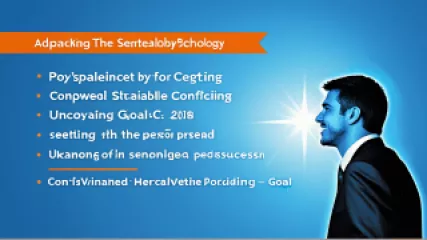Unlocking the Secrets of Success Psychology: A Step-by-Step Guide
Unlocking the Secrets of Success Psychology: A Step-by-Step Guide
In the pursuit of personal and professional growth, understanding the principles of success psychology has become increasingly vital. This comprehensive guide will take you on a transformative journey, unveiling the strategies and mindsets that have helped countless individuals achieve remarkable success. Prepare to embark on a voyage of self-discovery, where you'll uncover the keys to unlocking your full potential and embracing a positive, empowered mindset.
Cultivating a Positive Mindset: The Foundation of Success
At the heart of success psychology lies the fundamental belief that our thoughts and beliefs shape our reality. By adopting a positive, growth-oriented mindset, you can break free from limiting beliefs and embrace a world of boundless possibilities. In this section, we'll explore the power of positive thinking and how to cultivate a mindset that fosters success.
The Transformative Power of Positive Thinking
Positive thinking is not mere optimism; it's a strategic approach to reframing our perceptions and beliefs. When we shift our focus from the negative to the positive, we open ourselves up to new opportunities and unlock our full potential. Positive thinking has been scientifically proven to enhance resilience, boost motivation, and foster a sense of control over our lives. By consciously directing our thoughts towards constructive and empowering perspectives, we can break free from the constraints of self-doubt and fear, paving the way for remarkable achievements.
Overcoming Limiting Beliefs
One of the primary obstacles to success often lies within our own minds. Limiting beliefs, such as "I'm not good enough" or "Success is out of my reach," can sabotage our efforts and prevent us from reaching our full potential. In this section, we'll explore practical strategies for identifying and challenging these limiting beliefs, allowing you to replace them with more empowering and supportive mindsets.
"The only limit to our realization of tomorrow will be our doubts of today." - Franklin D. Roosevelt
By consciously questioning and reframing our limiting beliefs, we can unlock a world of new possibilities. This process involves examining the evidence behind our beliefs, analyzing their origins, and actively replacing them with more constructive perspectives. Through this empowering journey, you'll learn to embrace a mindset that fosters growth, resilience, and unwavering determination.
Goal-Setting and Visualization: Charting the Path to Success
Effective goal-setting and visualization are essential components of success psychology. In this section, we'll explore the strategies and techniques that can help you define clear, achievable goals and harness the power of visualization to bring them to life.
The Art of Goal-Setting
Setting well-defined, actionable goals is crucial for driving progress and maintaining motivation. The SMART goal-setting framework (Specific, Measurable, Achievable, Relevant, and Time-bound) provides a tried-and-true approach to crafting goals that inspire and empower. By breaking down your aspirations into smaller, manageable steps, you can create a roadmap to success that keeps you focused and on track.
The Power of Visualization
Visualization is a powerful tool in the realm of success psychology, allowing you to bring your goals to life and create a tangible vision of your desired outcomes. By vividly imagining yourself achieving your objectives, you activate the same neural pathways in your brain as if you were actually experiencing the success. This mental rehearsal not only boosts motivation and confidence but also helps you identify and overcome potential roadblocks along the way.
"Visualization is the greatest weapon we have to help us achieve our goals." - Waldo Reed
Through regular visualization exercises, you'll cultivate a deep, emotional connection to your aspirations, making them feel more accessible and achievable. This powerful technique can help you overcome self-doubt, fuel your determination, and propel you towards the realization of your dreams.
Developing Resilience and Adaptability
In the journey towards success, the ability to navigate setbacks and adapt to change is paramount. This section will explore the principles of resilience and adaptability, equipping you with the tools to overcome obstacles and thrive in the face of adversity.
Building Resilience: Bouncing Back from Setbacks
Resilience is the cornerstone of success psychology, allowing individuals to bounce back from failures, mistakes, and challenges. By cultivating a resilient mindset, you'll learn to view setbacks as opportunities for growth and development, rather than insurmountable obstacles. We'll delve into strategies for developing self-awareness, emotional regulation, and a growth-oriented perspective, empowering you to transform adversity into triumph.
Embracing Change and Adaptability
In an ever-evolving world, the ability to adapt to change is a crucial skill for success. Adaptability requires a willingness to learn, experiment, and step outside your comfort zone. This section will explore techniques for fostering a flexible, open-minded approach to life's challenges, enabling you to navigate uncertainty with confidence and capitalize on emerging opportunities.
"The measure of intelligence is the ability to change." - Albert Einstein
By cultivating resilience and adaptability, you'll develop the necessary tools to overcome setbacks, embrace change, and maintain a steadfast commitment to your goals, even in the face of adversity. This adaptive mindset will empower you to navigate the ever-changing landscape of success with grace and determination.
The Power of Positive Habits and Routines
Sustainable success is not merely a matter of motivation or talent; it is the result of consistent, positive habits and routines. In this section, we'll explore the transformative power of developing habits that support your personal and professional growth.
Establishing Empowering Habits
Habits are the building blocks of success. By consciously cultivating habits that align with your goals and values, you can create a foundation for long-term achievement. We'll delve into strategies for identifying and replacing detrimental habits with empowering ones, such as regular exercise, mindfulness practices, and focused productivity routines.
The Transformative Power of Routines
Routines provide structure, clarity, and a sense of control in our lives. By implementing intentional routines that support your personal and professional objectives, you can maximize your productivity, reduce stress, and foster a sense of purpose. From morning rituals to evening wind-down practices, we'll explore how to design routines that amplify your success and well-being.
"We are what we repeatedly do. Excellence, then, is not an act, but a habit." - Aristotle
By cultivating positive habits and routines, you'll create a supportive environment that nurtures your growth and helps you maintain momentum towards your goals. This transformative approach will empower you to develop sustainable, long-term success in all areas of your life.
The Role of Supportive Relationships and Accountability
Success is rarely achieved in isolation. In this section, we'll explore the profound impact that supportive relationships and accountability can have on your journey towards success.
Building a Supportive Network
Surrounding yourself with individuals who champion your growth and success is a powerful strategy in the realm of success psychology. Whether it's a mentor, a trusted peer group, or a community of like-minded individuals, cultivating these supportive relationships can provide invaluable guidance, encouragement, and a sense of belonging that fuels your progress.
The Power of Accountability
Accountability is a crucial element in the pursuit of success. By establishing clear goals and deadlines, and enlisting the support of an accountability partner or group, you can hold yourself responsible for your actions and stay on track towards your objectives. This external support system can help you overcome procrastination, maintain focus, and celebrate your achievements along the way.
"No man is an island. We all need the support and encouragement of others to reach our full potential." - Ted Ramirez
By cultivating a network of supportive relationships and embracing the power of accountability, you'll create a solid foundation for your success journey. These connections and external motivators will empower you to overcome challenges, celebrate your victories, and continue striving towards your highest aspirations.
Harnessing the Benefits of Online Therapy and Coaching
In the digital age, the realm of success psychology has been revolutionized by the rise of online therapy and coaching. This section will explore the unique advantages of these transformative tools and how they can amplify your journey towards personal and professional growth.
The Benefits of Online Therapy
Online therapy has emerged as a powerful resource for individuals seeking to overcome mental health challenges, develop a positive mindset, and unlock their full potential. By providing convenient, confidential access to licensed mental health professionals, online therapy offers a flexible and accessible solution for those seeking to enhance their success psychology. From cognitive-behavioral therapy to mindfulness-based interventions, these online sessions can help you cultivate the necessary skills and strategies to thrive in all areas of your life.
The Power of Online Coaching
Online coaching harnesses the expertise and guidance of experienced professionals to help individuals achieve their personal and professional goals. These personalized coaching sessions can cover a wide range of topics, from goal-setting and time management to leadership development and entrepreneurial success. By working one-on-one with a dedicated coach, you'll gain valuable insights, accountability, and the tailored support needed to unlock your full potential and achieve remarkable success.
"Online therapy and coaching have revolutionized the way we approach personal growth and success. These transformative tools empower individuals to transcend their limitations and unlock their true potential." - Brynn Banks
By embracing the power of online therapy and coaching, you'll gain access to a wealth of resources and personalized support that can propel you towards your desired outcomes. These innovative solutions offer a convenient, comprehensive, and effective approach to mastering the principles of success psychology.
Cultivating a Positive Mindset for Sustainable Success
In the final section of this comprehensive guide, we'll synthesize the key principles of success psychology and explore strategies for cultivating a positive mindset that fosters sustainable success.
Integrating the Principles of Success Psychology
The foundation of lasting success lies in the integration of the principles explored throughout this guide. By cultivating a positive mindset, setting empowering goals, developing resilience and adaptability, establishing positive habits and routines, and nurturing supportive relationships, you'll create a holistic framework for personal and professional growth.
Embracing a Positive Mindset for the Long-Term
Sustainable success is not a one-time achievement, but a continuous journey of personal development and self-improvement. By consistently practicing the strategies outlined in this guide and maintaining a positive, growth-oriented mindset, you'll be able to navigate life's ebbs and flows with grace, resilience, and unwavering determination. This transformative approach will empower you to not only attain your goals but also find joy, fulfillment, and a deeper sense of purpose in the process.
"The true path to success lies not in the destination, but in the journey itself. By embracing a positive mindset and a commitment to continuous growth, you'll unlock the keys to a life of lasting achievement and fulfillment." - Elianna Bell
As you embark on this transformative journey, remember that the principles of success psychology are not merely a set of strategies, but a holistic approach to living. By integrating these principles into your daily life and cultivating a positive, empowered mindset, you'll forge a path towards lasting success that transcends the boundaries of your current circumstances and propels you towards a future of boundless possibilities.






